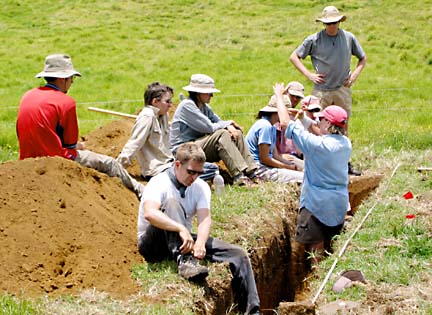
Researchers recently conducted a study of soils, climate and archaeological remains in the Big Island's Kohala region, finding that relatively recent volcanic eruptions several hundred thousand years ago created soil nutritionally rich enough to raise large quantities of sweet potatoes.
Kohala study finds
farming plots crucialAn agricultural system helped
to sustain Kamehameha's army
A vast dryland farming system that grew sweet potatoes supported large populations in the Big Island's Kohala region before European contact, researchers have found.
They believe the huge agricultural system enabled Kamehameha I to unify the Hawaiian Islands at the turn of the 18th century.
Michael Graves, University of Hawaii archaeologist and anthropology department chairman, said he has contended for some time that Kamehameha's efforts to expand his rule were underwritten by extensive Kohala agricultural production.
"It's something we haven't realized before," he said, pointing out Kamehameha needed to sustain a large army to succeed in his campaign.
Graves participated in a study of soils, climate and archaeological remains in the Kohala region reported in the June 11 issue of the journal Science. The paper is entitled "Soils, Agriculture, and Society in Precontact Hawaii."
Based on experimental plantings, he figured "if only half of the Kohala field system was in production in one year, it could be producing between 10,000 to 15,000 tons of sweet potato in one crop."
Such large-scale production required intensive labor, organization and transport of the surplus out of the area, he said, noting the people had to travel a great distance between coastal areas and the uplands.
"I am always amazed and impressed when I look at some of the areas Hawaiians would have been traversing prior to European contact," he said.
Graves said there are many archaeological features in the uplands, including remains of the field system and residential and occupation sites.
The field system was so large that people were probably farming in the uplands of more than 30 ahupuaa (land divisions from the sea to the mountains), he said.
Dates of charcoal collected beneath walls of the agriculture system suggest it began in the 15th or 16th century and expanded very rapidly, Graves said.
Two former Honolulu residents are principal investigators for the National Science Foundation-sponsored project: Patrick Kirch of the University of California-Berkeley and Peter Vitousek, Stanford University ecologist. Others participated from UC Santa Barbara and the University of Wisconsin.
Kirch, formerly of the Bishop Museum, has conducted extensive research throughout the Hawaiian Islands and Pacific and Vitousek studies Hawaiian ecosystems.
Graves said he and Thegn Ladefoged, University of Auckland anthropologist, volunteered to participate because they have been doing field work in Kohala since 1997.
They have pioneered with use of a relatively high accuracy global positioning system to map archaeological sites, Graves said. They are returning to Kohala this week to continue field work.
Relatively recent volcanic eruptions (several hundred thousand years ago) created areas as large as 25 square miles with nutritionally rich soil for sweet potatoes, the researchers found in analyzing soil samples.
They said archaeological remnants of the agriculture system on the leeward slope of the Kohala mountains match locations of the most abundant volcanic soil nutrients.
Only portions of the Big Island and Maui, the younger islands, had intensive dryland agriculture while the others primarily had wetland systems, which was puzzling until now, the team said.
Their research shows Kauai, Oahu and Molokai lacked what Vitousek calls "sweet spots" -- areas with both rainfall and fertile soil needed for sweet potatoes.
Also, nutrients were depleted in soils of the older islands.
Sweet potatoes don't have the symbolic importance of taro, Graves noted, but two crops could be grown in a good year.
By the late 1700s, Kirch said, the Hawaiians "were pushing agriculture to the limits" and the chiefs "had to go into a mode of aggressive action" to maintain their elite class system.
"It is interesting that the really aggressive chiefdoms came from the highly intensified dryland systems on Maui and Hawaii, where per capital yields were declining," Kirch said.
"They probably looked up the chain of islands toward Molokai and Oahu and said, 'I'd love to get hold of those taro paddies.'"
The vigorous Hawaii and Maui agricultural systems collapsed by the early 1800s, which historians attribute to human diseases arriving with Europeans and reducing Hawaiian populations and farm labor.
Vitousek, lead author of the Science article, said implications of the successes and failures of early Polynesians "extend well beyond the Hawaiian Islands" with lessons for tropical forest management today.
"Those (Polynesian) societies faced the challenge of making a transition from intensive, exploitative use of their island's obviously limited resources to more sustainable use of those resources," he wrote.
"We ourselves now face the challenge of global transition to sustainability; can we learn from societies that succeeded or failed on smaller worlds?"
The Vitousek Lab
Oceanic Archaeology Lab
Hawaii Archaeological Research Project
U.S. Geological Survey - Hawaii Volcanoes
